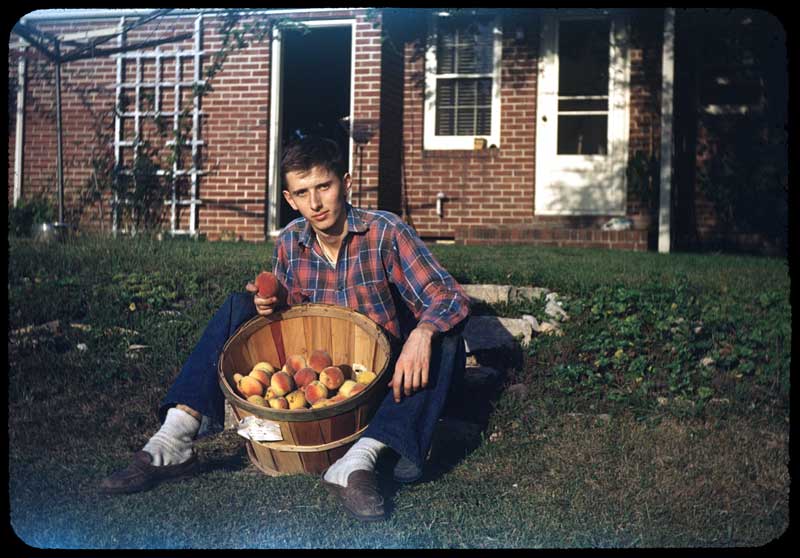


Framed or unframed, desk size to sofa size, printed by us in Arizona and Alabama since 2007. Explore now.
Shorpy is funded by you. Patreon contributors get an ad-free experience.
Learn more.

- Baldwin 62303
- Baldwin VO-1000
- Cold
- No expense spared
- Tough Guys
- Lost in Toyland
- And without gloves
- If I were a blindfolded time traveler
- Smoke Consumer Also Cooks
- Oh that stove!
- Possibly still there?
- What?!?
- $100 Reward
- Freeze Frame
- Texas Flyer wanted
- Just a Year Too Soon
- WWII -- Replacing men with women at the railroad crossing.
- Yes, Icing
- You kids drive me nuts!
- NOT An Easy Job
- I wonder
- Just add window boxes
- Icing Platform?
- Indiana Harbor Belt abides
- Freezing haze
- Corrections (for those who care)
- C&NW at Nelson
- Fallen Flags
- A dangerous job made worse
- Water Stop
Print Emporium
Peaches, mid-1940's

Anderson, Indiana - mid-1940's. This Kodachrome shows my father (Anton "Tony" Happel) with a basket of freshly picked peaches. From his appearance I'm guessing at the date (he graduated from high school in 1947 and he looks a bit younger than his senior photo in this image). The setting is the back yard of my grandparents' home. The peaches likely came from the fruit nursery that was across the street. The fruit grove was one of the reasons my Grandfather purchased that particular lot and built the house there in 1939/40. I think that this image was taken by my Aunt Lee (Dad's sister who was 10 years older than he). View full size.
Re: Mid-Century Color
Yes, this was from a Kodachrome slide. The mount is tan cardboard with a red border on the emulsion side. The only labeling other than the slide number are the words "Kodachrome Transparency" on the emulsion side and "Made in U.S.A." on the other side.
The bluish edge fogging - I'd guess a light leak involving the camera. This image was taken in the era when processing by Kodak was included with the cost of the film.
And while doing some research I found this on Wikipedia: "On June 22, 2009 Eastman Kodak Co. announced the end of Kodachrome production, citing declining demand. Many Kodak and independent laboratories once processed Kodachrome, but only one Kodak certified facility remained: Dwayne's Photo in Parsons, Kansas."
Early non-standard cassettes
Prior to Kodak's creation of the standardized size 135 cassette various camera manufacturers created their own cassettes specifically for their cameras. Leica is one such camera manufacturer. The Kodak 135 cassette was designed to be compatible with the Leica cameras.
The thick base 35mm film we use today evolved from the 35mm motion picture film that dates to around the turn of the previous century. It was never packaged as a paper backed roll film.
Kodak did market two different roll film formats that used 35mm wide film. These were both on a thinner base like other roll films. The first was 828, aka "Bantam," which was on a simple spool, had one sprocket per frame, and a standard image size of 28x40mm. Most 828 cameras used the numbers on the paper for manual indexing of the frames. A few fancy models used the sprocket.
The second format was the popular 126 "Instamatic" cartridge. It was much like 828 in that it had both printed numbers and one sprocket per frame. It was a square format 28x28mm, the same width as the Bantam image.
35mm cassettes
The 135 (ISO 1007) cassette for 35mm film was introduced by Kodak in 1934.
Mid-Century Color
Well, I'm endlessly fascinated by 1930s-1940s color photography. Not taking anything away from the artistic and technical masterpieces represented by the 4x5 government-sponsored Kodachromes we've been seeing here, everyday amateur examples like this can have a special you-are-there quality every bit as compelling for the glimpses they provide into the lives of ordinary folk. This chap certainly has a modern-day look about him. It's also a good example of the benefit of shooting during the golden hour.
Our own earliest color photos are from 1948, on Kodacolor negative film, like this one. The negatives from those have all become impenetrably dense, and I've had to restore the images from period prints, which themselves have faded and turned very yellow.
The color rendition here makes me suspect this is a Kodachrome. The bluish edge fogging? Light leak? We're used to 35mm still film being packaged in light-proof cassettes - was that the case in the earlier days? Or was it spooled like regular roll film that could get edge-fogged if you weren't careful when loading and unloading?
























On Shorpy:
Today’s Top 5